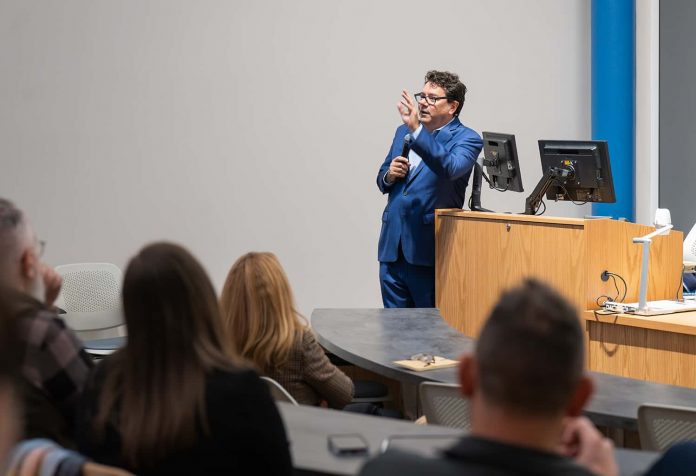Professor Vincent Pieribone has settled into his new office at Southern, fresh from his move across town from Yale University and the John B. Pierce Laboratory.
The co-CEO and chief science officer of OceanX, an initiative that sends missions into the deepest parts of the ocean, Pieribone is now part of Southern’s new B.S. in behavioral neuroscience program, which launched in fall 2024.
An adjunct professor of cellular and molecular physiology and neuroscience, he “brings new cachet to Southern,” according to Interim Provost Julia Irwin.
“He’s a superstar neuroscientist,” Irwin said. “He’s published in all the top journals. He’s incredibly innovative. He’s been using biofluorescence from the ocean to track cellular function in human and rodent brains.”
At Yale, Pieribone studied a fluorescent protein, which glows and allows him to see how the brain’s neural synapses work. The technique is superior to the former method of sticking electrodes into individual cells.
“The new way to do it was to try to use modern molecular biology that was this really robust technique, to put DNA into a nerve cell that would produce a protein that would fluoresce, meaning that you’d shine one color light on this protein, and it would produce another color,” Pieribone explained.
“So we would translate the electrical properties of a cell into optical properties so you could just image a bunch of nerve cells without sticking electrodes and watch their activity,” he said. “And that took us 10, 15 years, to be fair, of developing that concept into what was, two years ago, the piece de resistance of that line of work.
“We published a paper in Science and a paper in Nature Methods … demonstrating these synthetic proteins were able to record thousands of neurons simultaneously as they fire away. So we went from being neuroscientists to being synthetic biologists, biochemists,” he said.
Practical applications may include the ability to understand brain-based diseases such as schizophrenia and Parkinson’s disease, Pieribone said. “If you think about it, the brain is just this enigma,” he said, adding that the only brain-based disease for which a therapy exists is epilepsy.
“So the first step to it is being able to extract all of this information from the tissue while it’s working without killing it,” he said.
Pieribone’s research brings a new dimension to Southern’s new behavioral neuroscience program, which offers an interdisciplinary approach to studying the nervous system, promoting an in-depth understanding of brain function and behavior.
Research scientist Jelena Platisa, a colleague of Pieribone’s from Yale’s John B. Pierce Laboratory, has joined him at Southern, and they will be collaborating with neuroscience faculty, who come from the biology and psychology departments. Pieribone “deeply enriches a brand-new program that we’ve launched,” Irwin said.
“What his lab will do is bring in on-the-ground experts to allow students to learn some of the techniques that are used in neuroscience,” she said. “His lab will provide access and equipment that our students wouldn’t have gotten otherwise.”
Pieribone said his impression of Southern was positive the first time he toured the campus, and it’s continued since he’s joined the faculty.
“I honestly like working here a lot,” he said. “I love the people. I love the campus. The academic environment is terrific. The students are terrific. I didn’t have access to undergraduates at Yale Medical School.” At Yale, the emphasis was on research and focusing on his lab, he said. He also appreciates the diversity of Southern’s students and that many are first-time college students.
“Seeing the opportunity to have students around, young students, students who you could mold and you could create and who would work really hard is exciting. … I feel really invigorated,” he said.
Platisa agreed that Southern is “a very welcoming environment, very collaborative,” and she said that Pieribone is “a very generous person, he’s a very good colleague and a very good mentor. … He doesn’t put limits on himself in terms of fields of study or how he does things. … And then that translates to his collaborators.”


